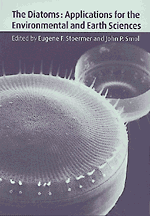Book contents
- Frontmatter
- Contents
- Contributors
- Preface
- Part I Introduction
- Part II Diatoms as indicators of environmental change in flowing waters and lakes
- Part III Diatoms as indicators in extreme environments
- 9 Diatoms as indicators of environmental change near arctic and alpine treeline
- 10 Freshwater diatoms as indicators of environmental change in the High Arctic
- 11 Diatoms as indicators of environmental change in antarctic freshwaters
- 12 Diatoms of aerial habitats
- Part IV Diatoms as indicators in marine and estuarine environments
- Part V Other applications
- Part VI Conclusions
- Glossary, and acronyms
- Index
12 - Diatoms of aerial habitats
Published online by Cambridge University Press: 16 January 2010
- Frontmatter
- Contents
- Contributors
- Preface
- Part I Introduction
- Part II Diatoms as indicators of environmental change in flowing waters and lakes
- Part III Diatoms as indicators in extreme environments
- 9 Diatoms as indicators of environmental change near arctic and alpine treeline
- 10 Freshwater diatoms as indicators of environmental change in the High Arctic
- 11 Diatoms as indicators of environmental change in antarctic freshwaters
- 12 Diatoms of aerial habitats
- Part IV Diatoms as indicators in marine and estuarine environments
- Part V Other applications
- Part VI Conclusions
- Glossary, and acronyms
- Index
Summary
Introduction
Although studied less than aquatic diatoms, aerial diatoms are discussed in an extensive literature. Most publications on the topic consist merely of floristic lists. Thus our understanding of aerial diatom ecology is meager. Given the brevity of the current chapter, it is not possible to list all of the pertinent literature. This paper will summarize aerial diatom studies based on floristic literature and my own work.
The most important early worker was probably Johannes Boye Petersen. Unlike many early soil phycologists, he treated diatoms with both detail and taxonomic accuracy. Petersen (1915, 1928, 1935) examined numerous aerial samples from Denmark, Iceland, and East Greenland. In all, he described 196 diatom taxa from soils, wet rocks, wet tree bark, and mosses, many of which were new to science at that time.
Other important early floristic works are those of Beger (1927, 1928), Krasske (1932, 1936, 1948), Hustedt (1942, 1949), Lund (1945), and Bock (1963). More recent studies report diatom floras associated with limestone caves, sandstone cliff faces, wet rocks, mosses, and soils. Added to these studies are numerous papers on aerial algae which discuss diatoms to some extent. Reviews on terrestrial algae have generally slighted the diatoms, although none have ignored them (Johansen, 1993; Metting, 1981; Novichkova-Ivanova, 1980; Starks et al., 1981; Hoffman, 1989).
Petersen (1935) defined a number of categories for aerial algae based on their habitat type. Euaerial algae inhabit raised prominent objects that receive moisture solely from the atmosphere.
- Type
- Chapter
- Information
- The DiatomsApplications for the Environmental and Earth Sciences, pp. 264 - 274Publisher: Cambridge University PressPrint publication year: 1999
- 19
- Cited by



